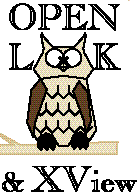
No Longer For Sale - Now Free!
OPEN LOOK was a specification for user interfaces, developed at the late, great Sun Microsystems with input from Xerox. XView was Sun's mainstream implementation of it (there were others), based on their earlier SunView toolkit. XView was completely open source, a first for a mainstream commercial UI toolkit.
The OPEN LOOK and XView Documentation and Source Code CD was a large but affordable collection of mostly-free software, focussing primarily on OPEN LOOK, XView, and the NeWS Window System. OPEN LOOK is a very good specification for a Graphical User Interface, or GUI, primarily popular on the UNIX and Linux operating systems. XView is an easy-to-use toolkit for writing OPEN LOOK programs under the X Window System. NeWS was Sun's Network extensible Window System, a faster, lighter-weight window system alternative to X. NeWS was designed by James Gosling, who later designed the Java Programming Language. Under the Common Open Systems Environment process, OPEN LOOK was "phased out", though it was at the time still actively used, both inside Sun and by their customers, and in the Linux and other free-software communities. And under competition from Display PostScript, the NeWS window system was also abandoned by Sun. We simply chose to provide a single source for all publicly-available material related to them.
Many people think that OPEN LOOK is a better GUI than (say) Motif. That's purely a matter of opinion, of course, but it's ours, and many share it. There are some good human-factors reasons why OPEN LOOK is more "intuitive." As well, the XView toolkit was the first free-software commercial-quality toolkit for developing full-scale X applications, and is widely used in the Sun and Linux communities (this is not to disparage Tk, QT or GTK, which came later).
Reviews
The OLCD actually got one review in the Linux Journal.
Where to get it now?
The declining use of XView lead to a drop in sales of the CD. It is still listed on Amazon and occasionally copies turn up there. However, meanwhile, I have open sourced it! Here's where to get the material:
- GitHub: Most of the documents, and the X-related program files, from the original CD-ROM image file (about 300 MB) are now archived on github.com.
- Book - Volume 3, OPEN LOOK
- Book - Volume 7A, XVIEW
- Book - Volume 7B, XVIEW
- The X Window System Source Code
- The XFree86 fork source code
- The MGR Window System Source Code, originally by Steve Uhler of Bellcore; a complete window system written by one person.
- XView Programs
The CD included at least these XView programs:
src/xview: facman olxvman sidtool xvmines-1.0 Ftptool4.6b4 faxtool1.2 owrolo sweeper-1.1 xvnews-2.3 NADagent fsptool-1.6.1 painter textedit xvnotice apex-1.1 genix_ui pan3.0 timekeeper xvokscript catcher gil2bil phonetool tree xvset_0.80 clock graphed privtool-0.83 videoteXt-0.5 xvtdl-5.0 cmdtool guide props workman xwb coffee index.html props_ui xcalentool yamailt_ui disktool-2.0 mahjongg2.1 rasview xrolo-2.06 xplan dstool moxftp-2.2 robotx0.48 xvgr-2.09 examples ol-wais scantool xvirtual
Back to Ian Darwin.